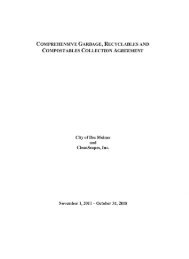CITY OF DES MOINES SHORELINE MASTER PROGRAM
CITY OF DES MOINES SHORELINE MASTER PROGRAM
CITY OF DES MOINES SHORELINE MASTER PROGRAM
You also want an ePaper? Increase the reach of your titles
YUMPU automatically turns print PDFs into web optimized ePapers that Google loves.
Des Moines Shoreline Inventory and Characterization<br />
Priority Habitats and Species<br />
The Washington Department of Fish and Wildlife (WDFW) maintains priority habitat and<br />
species information for Washington state, including the status of species as threatened or<br />
endangered. The City of Des Moines occurs within the WDFW Region 4. Priority habitats within<br />
Region 4 include consolidated marine/estuarine shorelines, cliffs, caves, snags, riparian areas,<br />
old-growth/mature forests, and urban open spaces. The following sections discuss some of the<br />
priority species and species of local importance that occur within the City’s shoreline<br />
jurisdiction.<br />
Shellfish<br />
Geoduck clams are documented in subtidal areas adjacent to shoreline Segments A, B, C, D, the<br />
northern one-half of Segment E, and G (Figure 14). Segment F is the only segment not showing<br />
the presence of geoduck clams (KCDNR, 2001). WDFW (2004) Marine Resource Species<br />
(MRS) data does not indicate the use of Segment F or G by geoducks. Intertidal hardshell clams<br />
are documented as occurring along the shorelines of Segment A, B, and the northern one-half of<br />
Segment C (WDFW, 2004 and KCDNR, 2001). Dungeness crabs are not documented as<br />
occurring within any of the shoreline segments (KCDNR, 2001). The King County 1996/1997<br />
Beach Assessment (KCDNR Website, 2004) performed at Saltwater State Park in Segment D<br />
documented shellfish use of these beach areas. Assessments of the Saltwater State Park shoreline<br />
(Segment D) resulted in the identification of 42 species of invertebrates, including native<br />
littleneck, macoma, manila, butter, horse, softshell, cockle, and geoduck clams; purple and green<br />
shore crabs, black-clawed crabs, red rock crabs, and graceful crabs; Sitka shrimp, and tubeworm<br />
hermit crabs. Macoma clams comprised nearly 40 percent of the population, but only accounted<br />
for three percent of the biomass. Conversely, horse and softshell clams only accounted for two<br />
percent of the population, but accounted for 28 percent of the biomass.<br />
In general, shellfish populations are relatively low in all shoreline segments. Population data<br />
analyzed by KCDNR (2001) indicates the following shellfish densities throughout the City’s<br />
shoreline jurisdiction: butter clams (



